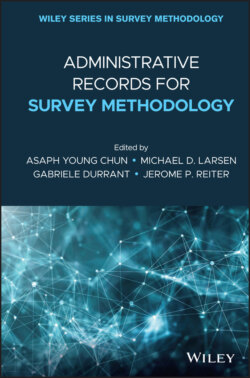Читать книгу Administrative Records for Survey Methodology - Группа авторов - Страница 28
2.1 Introduction
ОглавлениеThe use of administrative data has long been a part of the procedures at national statistical offices (NSOs), as evidenced in the various chapters in this book. The censuses and surveys conducted by NSOs may use sampling frames built at least partially from administrative data. For instance, the U.S. Census Bureau has used a business register – a list of all domestic businesses – derived from administrative tax filings since at least 1968. This register is the frame for its quinquennial censuses and annual surveys of business activity (DeSalvo, Limehouse, and Klimek 2016). It is also used to link businesses across surveys, to link surveyed businesses to other administrative record data, and as a direct source of statistical information on the levels and growth of business activity, published as the County Business Patterns (CBP) and Business Dynamics Statistics (BDS).1 Similar examples can be found in most countries that maintain some kind of registry for their businesses. In many countries, similar centrally maintained registers are used as frames for censuses and surveys of a country’s inhabitants and workers. Chapter 17 illustrates the Swedish approach to this problem for a national population census.2 The Institute for Employment Research (IAB), the research institute of the German Employment Agency, uses social security notifications filed by firms, and data generated from the administration of its mandated programs, to sample firms and workers. McMaster University and later Statistics Canada used administrative job termination notifications (“record of employment”) filed by employers to survey departing employees for the Canadian Out-of-Employment Panel (COEP) (Browning, Jones, and Kuhn 1995). Other uses of administrative data in NSOs include linkage for quality purposes (Chapters 8, 14, and 15), and data augmentation (Chapter 12 for the National Center for Health Statistics [NCHS] approach).
In addition, the increasing computerization of administrative records, has facilitated more extensive linking of previously disconnected administrative databases, to create more comprehensive and extensive information. Methods to link databases within administrative units based on common identifiers are easy to implement (see Chapter 9 for more details). In the United States, which does not have a legal national identifier or ID document, the increased use of the Social Security Number (SSN) has facilitated linkage of government databases and among commercial data providers. In many European countries, individuals have national identifiers, and efforts are underway to allow for cross-border linkages within the European Union, in order to improve statistics on the workforce and the businesses of the common economic area created by what is now called the European Union. However, even when common identifiers are not available, linkage is possible (see Chapter 15).
The result has been that data on individuals, households, and business have become richer, collected from an increasing variety of sources, both as designed surveys and censuses, as well as organically created “administrative” data. The desire to allow policy makers and researchers to leverage the rich linked data has been held back, however, by the concerns of citizens and businesses about privacy. In the 1960s in the United States, researchers had proposed a “National Data Bank” with the goal of combining survey and administrative data for use by researchers. Congress held hearings on the matter, and ultimately the project did not go forward (Kraus 2013). Instead, and partially as a consequence, privacy laws were formalized in the 1970s. The U.S. “Privacy Act” (Public Law 93-579, 5 U.S.C. § 552a), passed in 1974, specifically prohibited “matching” programs, linking data from different agencies. More recently, the 2016 Australian Census elicited substantial controversy when the Australian Bureau of Statistics (ABS) decided to keep identifiable data collected through the census for a substantially longer time period, with the explicit goal of enabling linkages between the census and administrative data, as well as linkages across historical censuses (Australian Bureau of Statistics 2015; Karp 2016).
Subsequent decades saw a decline in public availability of highly detailed microdata on people, households, and firms, and the emergence of new access mechanisms and data protection algorithms. This chapter will provide an overview of the methods that have been developed and implemented to safeguard privacy, while providing researchers the means to draw valid conclusions from protected data. The protection mechanisms we will describe are both physical and statistical (or algorithmic), but exist because of the need to balance the privacy of the respondents, including the confidentiality protection their data receive, with society’s need and desire for ever more detailed, timely, and accurate statistics.
